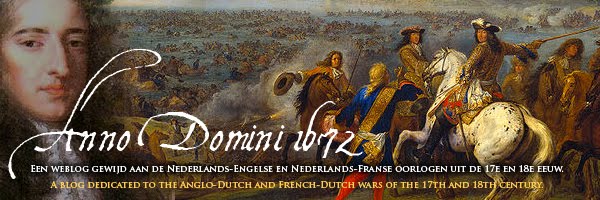
Het schilderij van Bock is eigenlijk alleen met een ladder (dan kan je namelijk ook het bovenste gedeelte wat beter zien) , en professionele lampen goed te fotograferen. Elke keer als ik er naar kijk, zie ik wel weer iets nieuws, varierend van een ruiter, tot een aantal lijken aan de galg op de galgenberg.
Op deze uitsnede, een groepje marcherende Munsterse soldaten. De gewone man is in het bruin, links vooraan staat er echter weer één in het blauw en ik neem aan dat het nogal patserige mannetje in het rood met de sierlijke hoed een officier is.
Op de achtergrond de rode vlaggen en een witte vlag. Het lijkt er op dat de Munstersen de gewoonte hadden om de kolonelsvlag ook in het wit te doen. Details op de vlaggen zijn niet zichtbaar.
~~
The only way to have a good look on the painting is using a scaffold and professional lighting. The council is planning to digitise it's collection, so maybe a art-historian will make some detail pics. I would like to thank the friendly people at city hall, for letting me take the pics anyhow.
A cut out of the painting showing marching Munster troops, mostly dressed in brown, with just one blue dressed gentleman in the ranks. I assume the cocky man in red with the posh hat is an officer. Also note the red flags and the one white flag. Maybe we can assume that the Munster army followed other nations by using a white colonels flag. Unfortunatly details on the flag can not bee seen.




I believe that Bock painted this picture ca. 1686. Many of the troops have a waistbelt that was not common in the 1670s. Was Bock present at the siege or are the troops based on uniforms from the time he painted the picture? On the other hand, grey, brown and blue would seem to be correct coat colors. Officers in many armies of the period wore red, as did noncommissioned officers.
BeantwoordenVerwijderenThe red flags for Münster also appear in gun batteries. It was a common practice in paintings and engravings to use a colored flag to indicate the location of various troop contingents, and does not necessarily mean that all Münster units carried red flags. de Hooghe's colored engravings of Stettin and Naarden are cases in point. The troops from Cologne have blue flags. Again to indicate their positions and to differentiate them from the Münster troops.
I have found one example of a flag from a Münster regiment that was captured by the Swedes on Rügen in 1678. It is white with the arms of Prince Bishop von Galen with inscriptions above and below the arms. There may be others in the Swedish State Trophy Collection which is possibly the only source for the appearance of Münster flags from this period.
Regards,
Dan
Well, like I said many times before, some answers could be gained on this painting and 'the other one', from people from city hall. On the Wouwermans painting of Coevorden, some Munster flags are red as well.
BeantwoordenVerwijderenA possible explanation for the blue flags may be the Bavarian connection of the Cologne bishop. I know from contemporary sources that a lot of Munster flags were captured, but I have no clue of their whereabouts.
I would caution against drawing too many conclusions from one or two paintings. As for the captured Münster colours, unless an attempt was made to preserve them or at least record their appearance, they have long disintegrated. Most were hung in churches and city halls, and literally fell apart. Not much hope of finding too many originals. One would have to examine correspondence and reports in the hope that there might be descriptions.
BeantwoordenVerwijderenDan